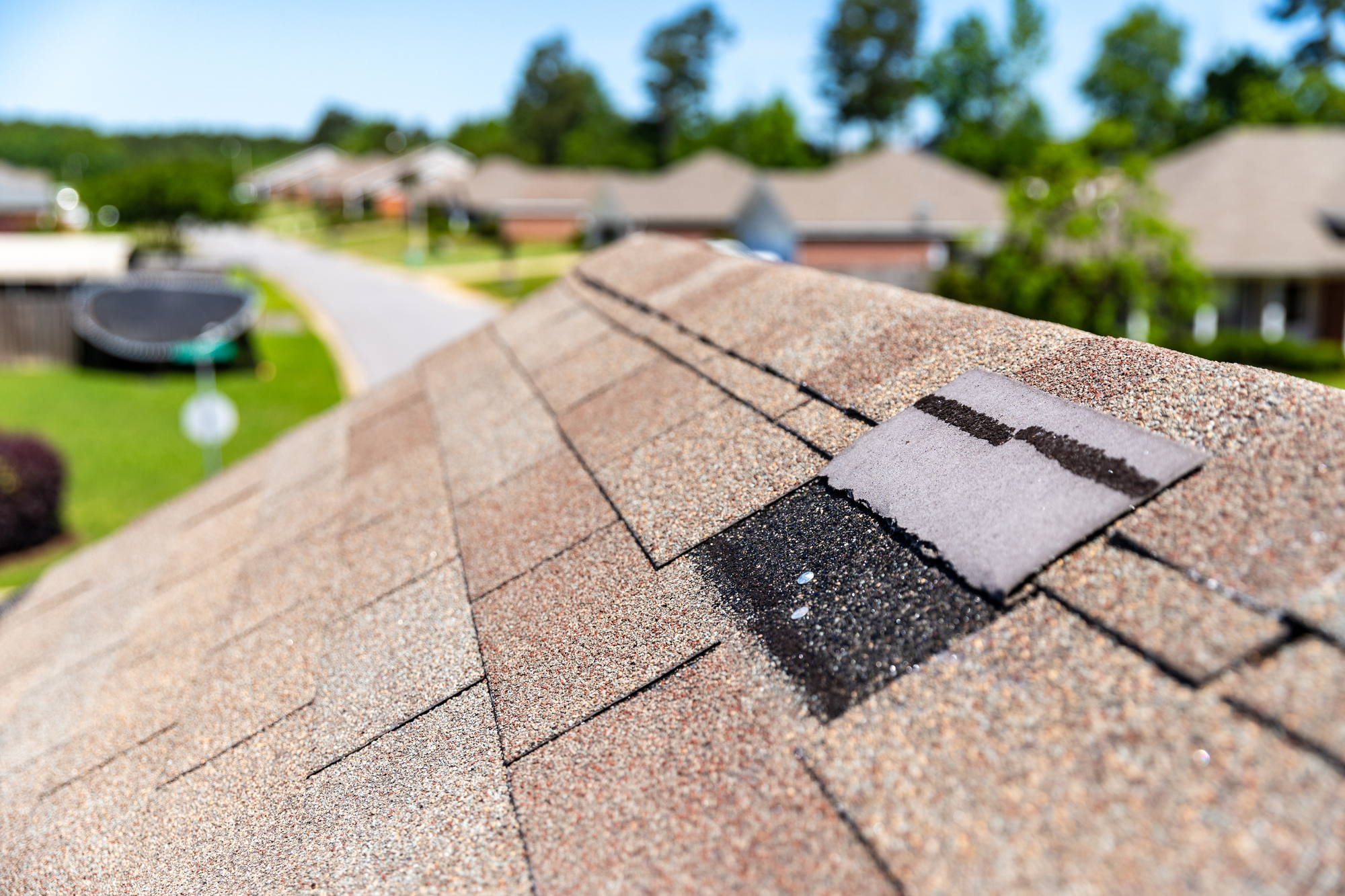
That bright spring sunshine can do more than just brighten your day—it can also shine a light on roof issues you didn’t even know were there. With the changing weather, your roof’s weak spots become more visible, whether it’s worn shingles or hidden leaks.
What seemed like a small concern last fall can suddenly be hard to ignore. Spring’s clear, direct light is the perfect opportunity to spot problems early, giving you the chance to fix them before they cause bigger headaches.
How Can Warmer Spring Weather Reveal Hidden Roof Damage?
The shift from winter to spring brings significant changes in temperature, moisture levels, and sunlight exposure. These changes can exacerbate any latent roof damage that has been hidden during the colder months.
While winter is often associated with snow, ice, and freezing temperatures, spring weather can do its own damage in less obvious ways. As the temperatures rise, ice that has been trapped in gutters or along roof edges begins to melt, which can expose weaknesses or damage that was previously concealed.
This sudden change in temperature can also cause roof materials to expand and contract, highlighting problems that were otherwise unnoticed.
The warmer weather can reveal issues such as:
- Cracks in the Roof Deck: When ice melts and moisture seeps into the cracks, the expansion and contraction process may make these cracks more visible as the roof warms up.
- Leaks: Leaks that were once sealed by layers of snow and ice may now be more noticeable as the sun dries out the roof and surrounding areas. This is especially true if there’s been a build-up of water around the edges.
- Worn Flashing: Flashing that has been compromised by winter weather can become more apparent as temperatures rise. Spring’s warmth can reveal areas where the flashing has pulled away or deteriorated, leading to potential water ingress.
- Sagging or Warping: If your roof materials are already weakened, the additional exposure to sunlight and the warming process can reveal areas that are sagging or warped, which may not have been visible during the winter months.
This is why many homeowners begin to notice their roof’s condition during spring—it’s not that the damage occurred in the last few months; it’s that the conditions have finally aligned to expose the problems.
What Seasonal Factors Make Roof Problems More Noticeable in Spring?
Several key seasonal factors make spring an ideal time to notice roofing issues that were not as visible during the winter. The interplay between temperature fluctuations, increased moisture, and exposure to sunlight plays a critical role in this process.
- Temperature Fluctuations: During the spring, the temperature can fluctuate dramatically—cold nights followed by warmer afternoons. These fluctuations cause roofing materials to expand and contract, which can highlight areas of weakness.
For instance, if shingles have become brittle during the winter or have developed small cracks, the temperature swings in spring can exacerbate the problem, causing them to peel away or break. These issues might go unnoticed in the winter, when colder temperatures maintain a more consistent pressure on the roof.
- Increased Moisture: Spring is typically the wettest season of the year. With frequent rain showers, snowmelt, and occasional spring storms, your roof faces an increased amount of moisture, which can reveal hidden leaks, cracks, and other problems.
Where winter’s snow might have temporarily sealed small leaks, the additional moisture brought by spring rains can flood those weak spots and make them more noticeable.
- Longer Days and More Sunlight: As the days grow longer and the sun shines brighter, more areas of your roof are exposed to direct sunlight, which can reveal flaws that were hidden in the winter. The warm rays of the sun can cause changes in the roof materials, bringing imperfections to the surface.
Roofs that are poorly insulated or ventilated might also experience more noticeable wear during spring, as they’re subject to greater swings in temperature.
- Wind and Storms: Springtime is notorious for its unpredictable weather, and strong winds or thunderstorms are not uncommon. The gusty winds can uncover damaged areas, lift or remove shingles, and expose areas that were previously shielded. Additionally, high winds can force debris—like tree branches or leaves—into gutters or onto the roof, further exacerbating any damage and creating potential blockages.
Why Do Certain Roofing Issues Remain Undetected Until Spring?
Certain roofing issues remain undetected throughout the year, only to become more apparent once the conditions are right in spring. These issues may go unnoticed during the colder months because the roof is often hidden behind layers of snow or because fewer people are actively inspecting the roof during winter.
Here’s why certain problems remain out of sight until spring:
- Winter Concealment: In many regions, heavy snowfalls and ice accumulation during winter months effectively hide roofing problems. Snow and ice can act as a temporary seal over roof leaks or areas of wear, making it difficult to detect damage. However, once the weather warms up and the snow begins to melt, those leaks and weak points may become more visible and easier to identify.
- Lack of Inspections in Winter: Many homeowners assume that winter is not the time for roof inspections, especially when it’s freezing outside. However, this can lead to missed opportunities to identify damage early on. Spring inspections are often the first chance homeowners have to assess the condition of their roofs after months of weather exposure, so any damage or wear accumulated over the winter months may only be spotted during the warmer weather.
- Moisture Build-Up: During winter, roofing materials may experience moisture build-up, especially if they’re not properly sealed. Snow or rainwater that collects on the roof can freeze overnight and thaw during the day, leading to changes in the roof’s structure that may go undetected until the roof begins to dry out in the spring. Once the thawing process begins, weakened areas or leaks that were not visible in the winter months are more likely to appear.
- Cold Weather Restrictions: Certain types of roof damage, particularly those caused by thermal expansion or contraction, may not be visible during the coldest months of the year. Cold temperatures can keep roof materials rigid and unyielding, meaning cracks or shifts may not appear until the materials expand with the warmer spring weather. This is particularly common with materials like asphalt shingles, which can become more pliable and prone to damage as they warm up.
How Does Sunlight Contribute to The Exposure of Roof Repair Issues?
The sun’s heat plays a key role in revealing roof repair problems. While we all enjoy the brightness and warmth the sun brings, it’s not always a friend to our roofs. Here’s how sunlight contributes to the exposure of roof repair issues:
- Thermal Expansion: As the sun’s rays heat up your roof, the materials begin to expand. If your roof already has underlying issues like cracks, loose shingles, or gaps, the warmth of the sun can cause these issues to become more pronounced. Expansion and contraction can pull materials apart, making weak spots and damage more visible.
- Surface Degradation: Over time, exposure to direct sunlight can degrade roofing materials, especially those that are not adequately protected. UV rays can break down the structure of shingles, causing them to crack, curl, or lose their protective granules. In the spring, sunlight acts as a magnifying glass, amplifying any areas of wear and tear that were previously masked by snow or cold weather.
- Increased Evaporation: As the sun heats up the roof, any accumulated moisture that has seeped into roofing materials begins to evaporate. This evaporation process can make previously undetected leaks more apparent, especially if water has been trapped under shingles or in the roof deck. The sun’s heat accelerates this evaporation, helping to reveal any damage that might have gone unnoticed during the winter months.
- Heat on the Roof Surface: Different areas of the roof will absorb heat at varying rates depending on their orientation. Parts of the roof that are exposed to direct sunlight will expand and contract more than shaded areas, making the problems in these sunlit areas stand out. For example, the shingles on the southern side of the roof may degrade faster and reveal more noticeable wear when spring comes.
That one sunny spring afternoon may feel like the perfect time to enjoy the warmth and brightness of the season, but it’s also the perfect opportunity for hidden roof repair nightmares to reveal themselves.
Keep Your Roof in Top Shape This Spring with Eason Roofing
At Eason Roofing, we specialize in keeping your roof protected, especially as the seasons shift. Spring brings with it the potential for hidden damage to the surface, and our team is here to help you catch any issues early before they turn into costly repairs.
By choosing Eason Roofing, you benefit from:
- Comprehensive Roof Inspections: Our experienced professionals will conduct a detailed inspection of your roof to catch hidden issues like leaks, cracked shingles, and weakened flashing, ensuring nothing is missed.
- Expert Cleaning and Maintenance: We’ll clear debris from gutters, downspouts, and roof valleys, preventing water buildup and potential damage during the rainy spring months.
- Preventive Solutions: With our preventive maintenance services, you’ll extend the life of your roof and avoid expensive emergency repairs later.
- Prompt, Reliable Service: We understand that roof issues can’t wait, so we offer fast service with minimal disruption to your daily life.
Don’t wait until the damage is severe—contact Eason Roofing today to schedule your spring roof inspection and ensure your home is ready for the season ahead!





